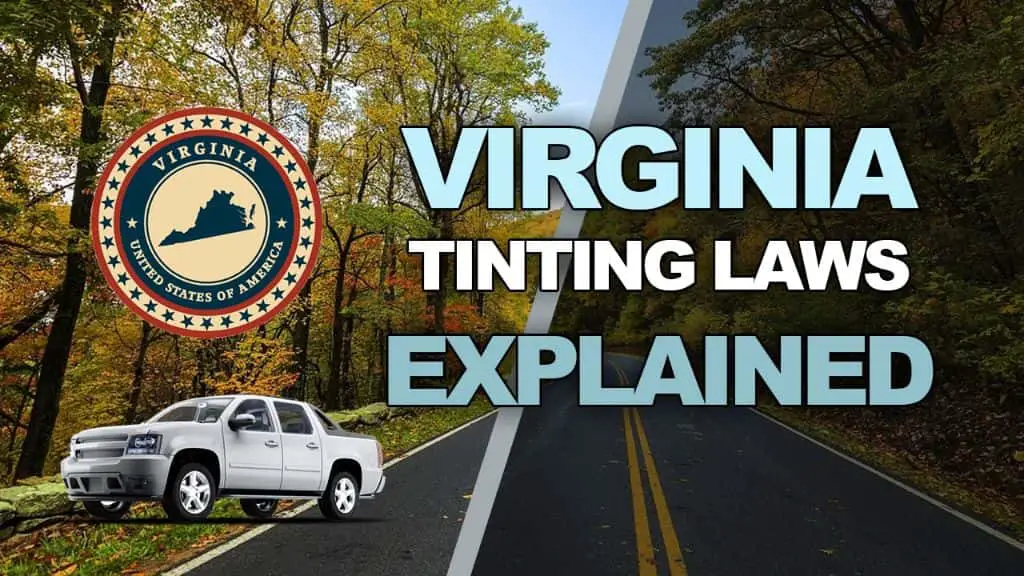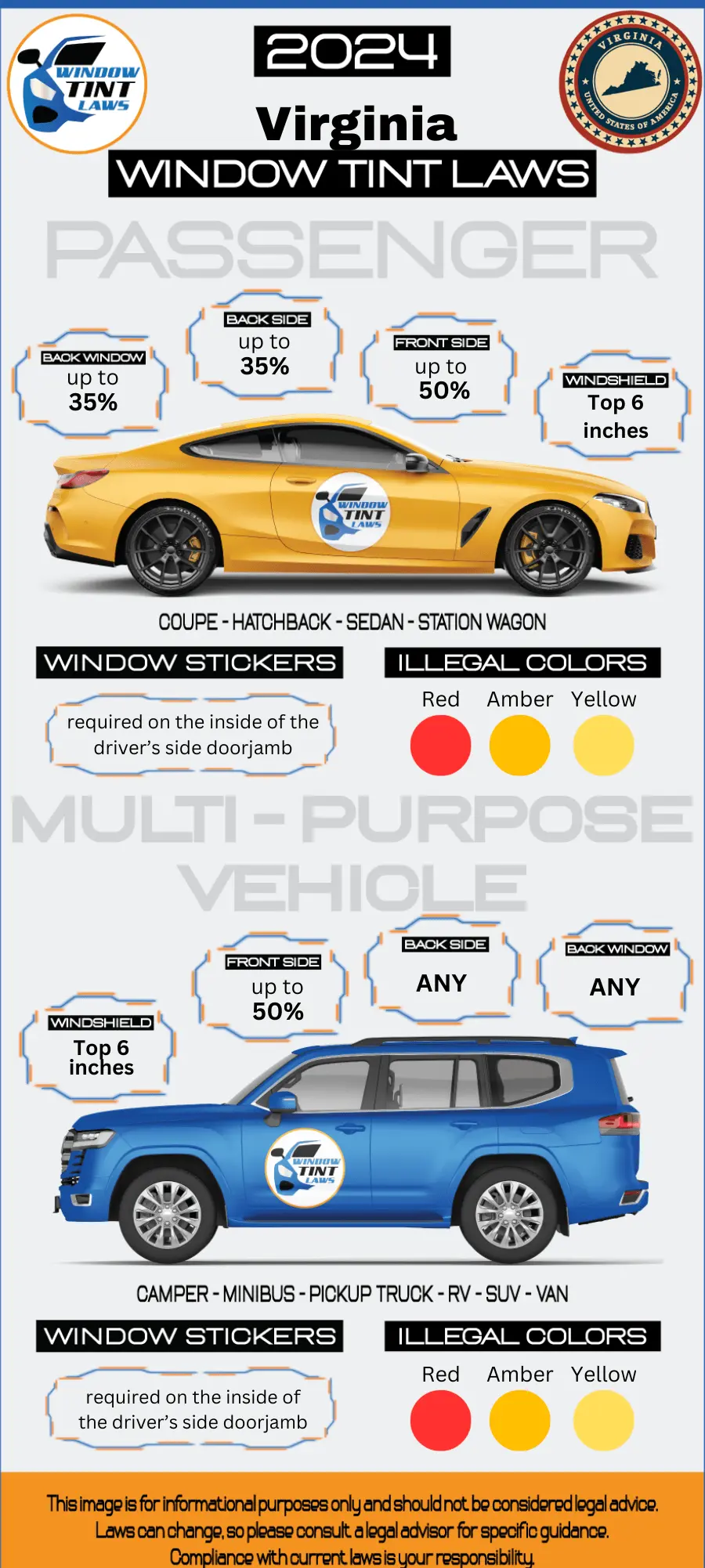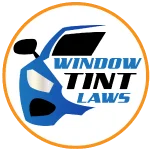

Article Created by Ryan Pietrzak
Last updated on February 14, 2024Virginia Tint Laws – 2024 Updated Legal Tint Limit
Please note that Virginia Tint Laws Regulation can change daily and may be interpreted differently at the city or county level. We recommend verifying this information with your local DMV or law enforcement agencies. We have manually fact-checked this content using official state resources. Virginia enacted tinting laws in 1999. If any information provided is incorrect or outdated, please contact us so we can make the necessary corrections. Thank you.
2024 Virginia Tint Laws – Legal Tint Limit For Passenger Vehicles.
- Front Windshield: Non-reflective tint is allowed on the top 6 inches of the windshield.
- Front seat side windows: up to 50% tint darkness allowed
- Back seat side windows: up to 35% tint darkness allowed
- Rear window: up to 35% tint darkness allowed
2024 Virginia Tint Laws – Legal Tint Limit For Multi-Purpose Vehicles
- Front Windshield: Non-reflective tint is allowed on the top 6 inches of the windshield.
- Front seat side windows: up to 50% tint darkness allowed
- Back seat side windows: Any tint darkness can be used
- Rear window: Any tint darkness can be used

- Medical exemptions: Virginia tint laws permit darker tints on front side windows with a doctor’s note
- Virginia tint laws prohibit metallic or reflective tint on any of the windows
- Virginia tint laws are statewide with no additional local regulations
- Violating Virginia tint laws can vary depending on the specifics of the violation and the discretion of law enforcement. Generally, fines for window tint violations can range from approximately $25 to $75 or more.
What does VLT Mean according to Virginia Tint Laws?
- Window tint film’s light transmission is measured as VLT (Visible Light Transmission) and each state has its own legal limits for VLT on car windows.
- A HIGHER VLT means that more light is allowed to pass through the window tint film.
- Example: a 75% tint will allow 75% of the light to pass through whereas a 5% tint will only allow 5% of the light to pass through, making the 5% tint a much darker film.
- Virginia window tint laws has specific VLT limits for Passenger Vehicles and Multi-Purpose Vehicles.
FAQ’s Regarding Virginia Tint Laws and Virginia Legal Tint Limit
What is the darkest legal tint in Virginia?
In Virginia car tint laws, the darkest legal tint for the front side windows of vehicles must allow more than 50% of light to pass through. For the back side windows and rear window of sedans, a minimum of 35% of light must be allowed through the tint. SUVs and vans have more flexibility, with no specific restrictions on the level of tint darkness for their back side and rear windows.
Are police exempt from window tint laws in Virginia?
According to Virginia tint laws, law enforcement vehicles are subject to different tinting regulations compared to civilian vehicles. These special provisions allow police cars to have darker tints for operational effectiveness and officer safety. However, these vehicles are still required to adhere to certain restrictions to ensure public safety. This means that while they may have some exemptions for darker tints, they are not completely exempt from all window tinting laws
How do I get a tint waiver in Virginia?
To obtain a window tint waiver in Virginia for medical reasons, you should first contact the Virginia Department of Motor Vehicles (DMV) or visit their official website for the required forms and guidelines. You must then obtain a medical certificate or letter from a licensed medical professional, explaining your medical condition and the need for window tinting. After completing the necessary application form and attaching the medical documentation, submit it to the Virginia DMV as per their instructions. If approved, they will provide you with a certificate or decal indicating your exemption
How much is a tint ticket in Virginia?
Virginia tint laws will vary depending on the specifics of the violation and the discretion of law enforcement. Generally, fines for window tint violations can range from approximately $25 to $75 or more. It’s important to note that these amounts can change
Can you get pulled over for tint in Virginia?
Yes, in Virginia, you can be pulled over for having window tint that is not in compliance with state regulations. Law enforcement officers are authorized to stop vehicles if they believe the window tint is darker than the legal limit. During such stops, officers may use tint meters to measure the Visible Light Transmission (VLT) of the tint to ensure it meets the legal requirements.
How to get a Tint Exemption in Virginia
To apply for a medical authorization in Virginia, the person with the medical condition must submit a completed Sun-Shading Medical Authorization Application (MD-20) to DMV. The application must include vehicle information and a statement from a physician, physician’s assistant, nurse practitioner, ophthalmologist, or optometrist certifying that sunshading is necessary for the individual’s health.
The vehicle owner will receive a new registration card with “sunshading” printed in the Special Conditions space. This registration card serves as verification that the vehicle is authorized to have sunshading.
With a medical exemption, you are permitted to tint front side windows down to 35% VLT. The entire front windshield can be tinted to 70% VLT, and the top 5 inches (AS-1 line) of the windshield can have 35% VLT.
For more information regarding window tint medical exemptions in _____ you can check out this resource:
- Virginia DMV – Vehicle sun-shading medical authorization
- Virginia DMV – Sun-shading medical authorization application (.pdf form)

Ryan Pietrzak
Creator of Windowtintlaws.us
